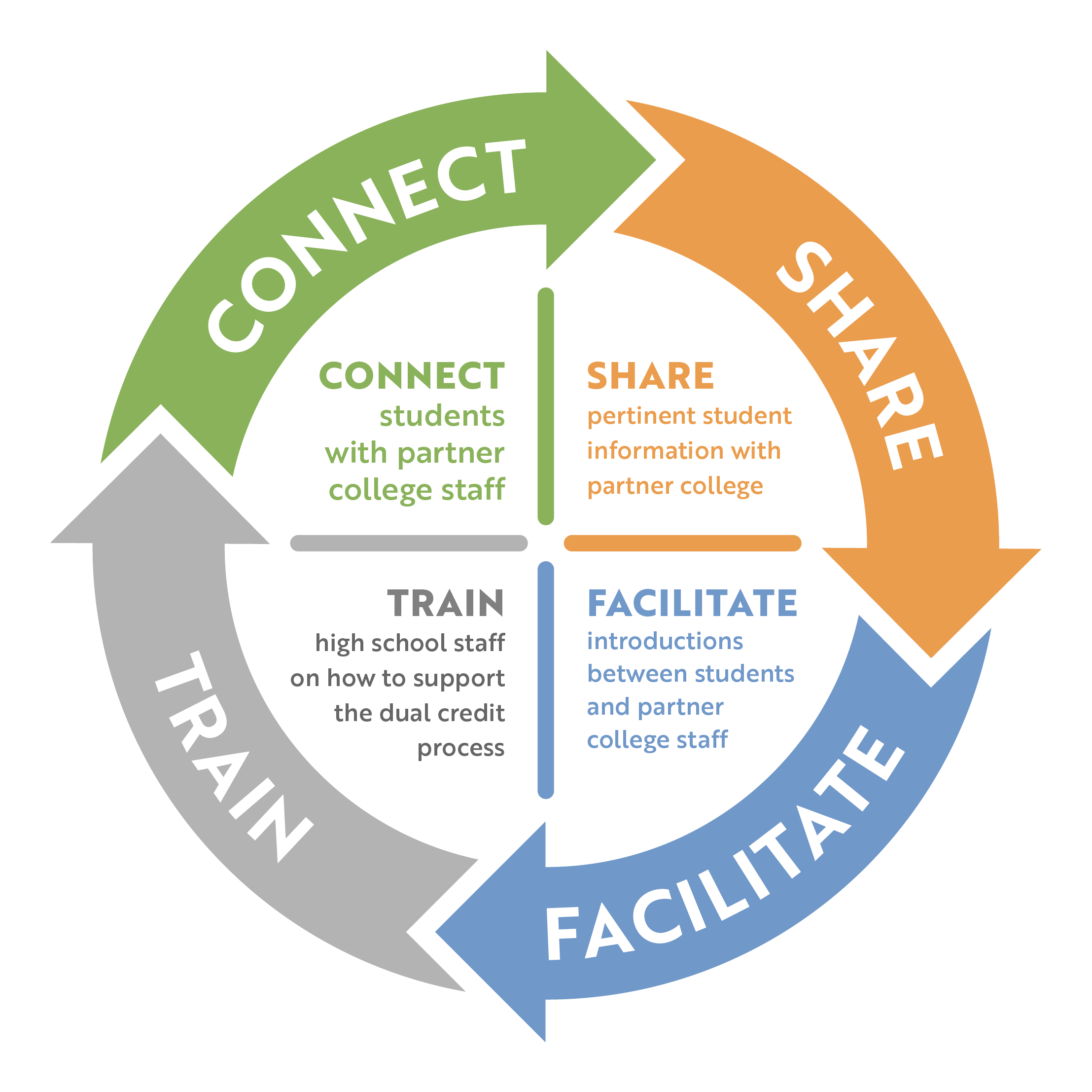Early career and academic exploration, advising, and planning
Actionable Takeaways
- Schools should consider how they can provide ongoing professional development of high school counselors to enhance their knowledge and skills in college and career planning, including components that are specific to dual credit.
- To create a more cohesive and successful dual credit program, schools should develop an intentional infrastructure and partnerships that support the program’s execution.
- Schools should foster strong partnerships with colleges and community-based organizations to expand support services and provide students with access to external resources, such as peer mentoring and additional advising, enhancing their college and career navigation.
Dedicate resources to ensure high school counselors can focus on college and career planning for all students whether they want to go to college or pursue other postsecondary options.
To ensure that educators can focus on college and career planning for all students, regardless of their postsecondary plans, schools should consider dedicating resources to support their work. Some strategies that can be used to accomplish this goal include:
- Provide ongoing professional development: Schools should invest in ongoing professional development for counselors to ensure that they have the knowledge and skills necessary to support all students in their college and career planning, including awareness of differences of available disability services and supports in high school and college.
- Develop clear college and career pathways: Schools should work to develop clear pathways that outline the steps students need to take to pursue their postsecondary goals, whether that be college or a career. This can help to ensure that counselors have the necessary resources and information to support students in their planning.
By dedicating resources to support counselors’ work, schools can ensure that all students receive the necessary guidance and support to pursue their postsecondary goals, whether that be college or a career.
Develop strong infrastructure and utilize partnerships to provide career and academic exploration.
High schools that are providing dual credit course offerings should have a well-defined infrastructure that supports course progressions, sequencing, and overall program implementation. Some key elements of a strong infrastructure include:
- Dual Credit Course Sequencing: High schools should develop a clear sequence of courses that allows students to progress through the dual credit program in a logical and coherent way. This can include prerequisites, recommended course sequences, and clear pathways for students to follow, as well as course scheduling that allows students to participate in dual credit courses.
- Course Alignment: High schools should align their dual credit courses with college-level expectations to ensure that students are adequately prepared for the rigors of postsecondary education. This can include using college-level textbooks, assignments, and assessments.
- Instructor Qualifications: High schools must ensure that their dual credit instructors meet the same qualifications as college instructors in their subject area. This can include having advanced degrees or relevant industry experience; requirements vary and is largely dependent on the form of dual credit course offered and the partnership between the high school and higher education partner. High school staff will need to be approved in the same manner as adjunct faculty at the college to teach the course.
- Program Evaluation: High schools should regularly evaluate their dual credit programs to ensure that they are meeting the needs of students and achieving the desired outcomes. This can include tracking student enrollment and completion rates, assessing student performance on college-level assessments, and collecting feedback from students and instructors.
By establishing this type of infrastructure, high schools can create a more cohesive and effective dual credit program that prepares students for postsecondary success.
In addition to a strong infrastructure, schools should utilize partnerships such as Career and College Bridge for All, that support college and career navigation by providing advising via peer mentoring. Partnering with community based organizations increases the capacity of schools and expands support services for students, and may allow for connections and access to external resources that schools do not directly have.
Connect dual credit students with partner colleges’ advising and planning staff so that students can discuss their postsecondary plans with high school staff as well as with staff at the college.
Connecting dual credit students with partner colleges’ advising and planning staff is an important step in supporting students’ postsecondary success. High schools can take several actions to facilitate this connection. Firstly, they should establish clear communication channels with partner colleges’ advising and planning staff so that students can easily reach out to college staff for support and guidance, as needed.
Secondly, high schools should share relevant student information, such as transcripts and test scores, with partner colleges’ advising and planning staff. This can help college staff better understand the needs and goals of each student and provide more targeted support. Coordinating meetings between dual credit students and partner colleges’ advising and planning staff is also crucial. These meetings can be held virtually or in person and provide students with the opportunity to discuss their postsecondary plans with both high school staff and college staff. This can help students make informed decisions about their academic and career goals. One potential opportunity is to have a college advisor meet with a dual credit class during a class period toward the end of the semester, thus allowing for the ability for all students to hear from the advisor.
High schools should provide training for high school staff on how to effectively connect dual credit students with partner colleges’ advising and planning staff. This can include training on communication strategies, data sharing protocols, and how to coordinate meetings. By taking these steps, high schools can help ensure that their dual credit students have the support and guidance they need to achieve their postsecondary goals. This approach can help to increase student success in college and the workforce, while also building stronger relationships between high schools and partner colleges.



